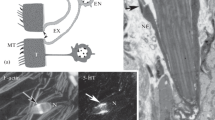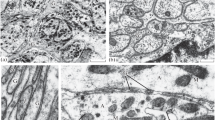Summary
Using fluorescence microscopy with pseudoisocyaninchloride one can demonstrate the well known cells and axons of the neurosecretory system in the cerebral ganglia of some gastropod pulmonates. In the other ganglia of the central nervous system-except procerebrum-single secretory neurones or groups of neurosecretory cells occur. These secretory neurones do not build up a neurosecretory system. The majority of these cells is concentrated in the visceral-parietal ganglia. The specific elements are topographically identifiable relative to each other in the ganglia of each species of pulmonates investigated. Other fluorescence-microscopic investigations of the neurones, glial cells and the neuropil of the ganglia, commissures and nerves and in the connective tissue surrounding the ganglia are described in comparison with other light microscopical findings obtained by staining methods; the results are discussed.
Zusammenfassung
Durch Anwendung von Pseudoisocyaninchlorid lassen sich im zentralen Nervensystem von stylommatophoren Pulmonaten in allen Schlundringganglien Neurosekretzellen fluoreszenzmikroskopisch nachweisen. In den Cerebralganglien bilden sie mit ihren ausleitenden Axonen das bereits bei einigen Gastropoden bekannte geschlossene neurosekretorische System. In den übrigen Ganglien liegen die neurosekretorischen Zellen einzeln oder in Gruppen zusammen und bilden kein System. Es konnte nachgewiesen werden, daß in Visceral-Parietaganglien der untersuchten Arten die meisten sekretorischen Neurone vorkommen. Die Zahl der neurosekretorischen Zellen in den einzelnen Ganglien ist zumindest für die hier untersuchten Arten wahrscheinlich artspezifisch, ihre topographische Lage in den Ganglien aber bei allen Arten identifizierbar ähnlich. Bei allen untersuchten Pulmonaten fanden sich nur im Procerebrum keine neurosekretorischen Zellen. Die vielfältigen, über die Darstellung der Neurosekretzellen hinaus feststellbaren fluoreszenzmikroskopischen Erscheinungen in den Nerven- und Gliazellen, in der Fasermasse der Ganglien, den Kommissuren und Nerven und im Bindegewebe um die Ganglien, wurden mit Hilfe anderer lichtmikroskopischer Färbungen vergleichend untersucht; die Ergebnisse werden diskutiert.
Similar content being viewed by others
Literatur
Andrews, E. B.: An anatomical and histological study of the nervous system ofBithynia tentaculata (Prosobranchia), with special reference to possible neurosecretory activity. Proc. malac. Soc. (Lond.)38, 213–232 (1968).
Baecker, R.: Die Mikromorphologie vonHelix pomatia und einiger anderer Stylommatophoren. Ergebn. Anat. Entwickl.-Gesch.29, 449–585 (1932).
Bargmann, W., Lindner, E., Andres, K. H.: Über Synapsen an endokrinen Epithelzellen und die Definition sekretorischer Neurone. Untersuchungen am Zwischenlappen der Katzenhypophyse. Z. Zellforsch.77, 282–298 (1967).
Boer, H. H.: A cytological and cytochemical study of neurosecretory cells in Basommatophora, with particular reference toLymnaea stagnalis L. Arch. néerl. Zool.16, 313–386 (1965).
—, Douma, E., Koksma, J. M. A.: Electron microscope study of neurosecretory cells and neurohaemal organs in the pond snailLymnaea stagnalis. Symp. zool. Soc. (Lond.)22, 237–256 (1968).
Brink, M., Boer, H. H.: An electron microscopical investigation of the follicle gland (cerebral gland) and of some neurosecretory cells in the lateral lobe of the cerebral ganglion of the pulmonate gastropodLymnaea stagnalis L. Z. Zellforsch.79, 230–243 (1967).
Coggeshall, R. E., Kandel, E. R., Kupfermann, I., Waziri, R.: A morphological and functional study on an cluster of identifiable cells in the abdominal ganglion ofAplysia californica. J. Cell Biol.31, 363–368 (1966).
Dahl, E., Falck, B., Mecklenburg, C. v., Myhrberg, H., Rosengren, E.: Neuronal localization of Dopamine and 5-Hydroxytryptamine in some mollusca. Z. Zellforsch.71, 489–498 (1966).
Durchon, M.: L'endocrinologie des Vers et des Mollusques. Paris: Masson & Cie. 1967.
Förster, Th.: Fluoreszenz organischer Verbindungen, Göttingen: Vandenhoeck und Ruprecht 1951.
Gabe, M.: Particularités morphologiques des cellules neuro-sécrétrices chez quelques Prosobranches monotocardes. C.R.Acad. Sci. (Paris)236, 323–325 (1953).
—: Neurosecretion. Oxford: Pergamon Press 1966.
Gersch, M.: Vergleichende Endokrinologie der wirbellosen Tiere. Leipzig: Akad. Verlagsges. Geest und Poertig 1964.
Gorf, A.: Untersuchungen über Neurosekretion bei der SumpfdeckelschneckeVivipara vivi-para L. Zool. Jb. Abt. allg. Zool. u. Physiol.69, 379–404 (1961).
Hanneforth, W.: Struktur und Funktion von Synapsen und synaptischen Grana in Gastropodennerven. Z. vergl. Physiol.49, 485–520 (1965).
Kerkut, G. A., Sedden, C. B., Walker, R. J.: Uptake of Dopa and 5-Hydroxytryptophan by monoamine-forming neurones in the brain ofHelix aspersa. Comp. Biochem. Physiol.23, 159–162 (1967).
Krause, E.: Untersuchungen über die Neurosekretion im Schlundring vonHelix pomatia L. Z. Zellforsch.51, 748–776 (1960).
Kuhlmann, D.: Neurosekretion bei Heliciden. Z. Zellforsch.60, 909–932 (1963).
—: Der Dorsalkörper der Stylommatophoren (Gastropoda). Z. wiss. Zool.173, 218–231 (1966).
—: Vergleichende fluoreszenzmikroskopische und elektronenmikroskopische Untersuchungen am zentralen Nervensystem vonPlanorbarius corneus L. (Basommatophora). Z. Zellforsch.110, 131–152 (1970).
Nolte, A.: Neurohämal-„Organe“ bei Pulmonaten (Gastropoda). Zool. Jb. Abt. Anat. u. Ontog.82, 365–380 (1965).
—, Breucker, H., Kuhlmann, D.: Cytosomale Einschlüsse und Neurosekret im Nervengewebe von Gastropoden. Z. Zellforsch.68, 1–27 (1965).
—, Kuhlmann, D.: Histologie und Sekretion der Cerebraldrüse adulter Stylommatophoren (Gastropoda). Z. Zellforsch.63, 550–567 (1964).
Röhnisch, S.: Untersuchungen zur Neurosekretion beiPlanorbarius corneus L. (Basommatophora). Z. Zellforsch.63, 767–798 (1964).
Sakharov, D. A.: Recent studies of the properties of nudibranch nerve cells. Comp. Biochem. Physiol.18, 957–959 (1966).
—, Borovyagin, V. L., Zs.-Nagy, I.: Light, fluorescence and electron microscopic studies on „neurosecretion“ inTritonia diomedia Bergh (Mollusca, Nudibranchia). Z. Zellforsch.68, 660–673 (1965).
—, Zs.-Nagy, I.: Localization of biogenic Monoamines in cerebral ganglia ofLymnaea stagnalis L. Acta biol. Acad. Sci. hung.19 (2), 145–157 (1968).
Schloot, W.: Postembryogenese vonHelix pomatia L. (Gastropoda) unter Berücksichtigung der Sekretion der Nervenzellen. Z. Zellforsch.67, 406–426 (1965).
Simpson, L., Bern, H. A., Nishioka, R.: Survey of evidence for neurosecretion on gastropod molluscs. Amer. Zoologist6, 123–138 (1966a).
— — —: Examination of the evidence for neurosecretion in the nervous system ofHelisoma tenue (Gastropoda Pulmonata). Gen. comp. Endocr.7, 525–548 (1966b).
Sterba, G.: Fluoreszenzmikroskopische Untersuchungen über die Neurosekretion beim Bachneunauge (Lampetra planari Bloch.). Z. Zellforsch.55, 763–789 (1961).
—, Hoheisel, H.: Darstellung des neurosekretorischen Systems der Insekten mit Pseudoisocyanin. Z. mikr.-anat. Forsch.72, 31–48 (1964).
—, Wellner, K.-P.: Biochemische Korrelation der Pseudoisocyaninreaktion zum Nachweis von Neurosekret. Naturwissenschaften50, 334–335 (1963).
Van Mol, J.-J.: Phénomènes neurosécrétoires dans les ganglions cérébroides d'Arion rufus. C. R. Acad. Sci. (Paris)250, 2280–2281 (1960).
—: Etude morphologique et phylogénétique du ganglion cérébroide des Gastéropodes Pulmonés (Mollusques), Acad. Roy. Belg., Cl. Sci.37, 1–168 (1967).
Vicente, N.: Histophysiologie du système nerveux des Gastéropodes Opisthobranches. Phénomènes neurosécrétoires. Rec. Trav. St. Mar. Endoume, Bull., 46, Fasc.62, 13–121 (1969).
Wondrak, G.: Die Ultrastruktur der Zellen aus dem interstitiellen Bindegewebe vonArion rufus (L.), Pulmonata, Gastropoda. Z. Zellforsch.95, 249–262 (1969).
Zs.-Nagy, I.: Fluorescent-microscopic examination with Pseudoisocyanin on the neurosecretory activities of the fresh water musselAnodonta cygnea L. Annal. Biol. Tihany32, 123–127 (1965).
Author information
Authors and Affiliations
Rights and permissions
About this article
Cite this article
Kuhlmann, D. Fluoreszenzmikroskopische Untersuchungen mit Pseudoisocyaninchlorid am Schlundring einiger stylommatophorer Pulmonaten. Z.Zellforsch 113, 344–360 (1971). https://doi.org/10.1007/BF00968544
Received:
Issue Date:
DOI: https://doi.org/10.1007/BF00968544




